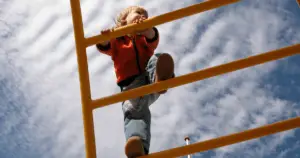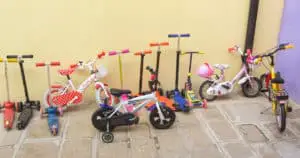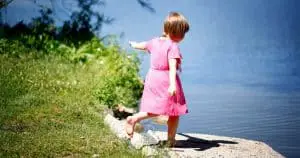Playdough is a wonderful toy for children and it is very educational for them to play with as well. There are many benefits to playing with playdough for toddlers and it can provide hours of creative play for them.
The benefits of playing with playdough include developing fine motor skills, improving hand and eye coordination, and encouraging creativity and imaginative play. Playing with playdough is a screen-free activity that encourages both independent and cooperative play.
Many parents avoid allowing their children to play with playdough because it can be a bit messy. However, if you provide an appropriate play space for them to explore playdough the benefits of playing with playdough to their development far outweigh the mess.

Contents
7 Benefits of Playdough for Toddlers
- Develops fine motor skills.
- Introduces sensory play.
- Builds hand and eye coordination.
- Encourages concentration.
- Teaches socioemotional skills through independent and cooperative play.
- Builds self-esteem and confidence.
- Encourages creativity and imagination.
- Develops critical thinking skills.
Playing with playdough Benefits

Fine Motor Skill Development
One of the ways that playdough benefits development for children is the ability to practice their fine motor skills. When toddlers are rolling, pinching, squeezing, and poking playdough they are building and strengthening the muscles in their fingers and hands.
Toddlers are also learning how to push, pull, and squish with their small hands and fingers. Some of the additional benefits of playing with playdough and building fine motor skills include preparing those small hands for holding a pencil in a pincer grasp and getting ready to hold scissors for cutting.
Sensory Play
Another benefit of playdough for toddlers is the ability to include sensory play in their learning experiences. How does the playdough feel? How does it smell? What is the texture of the playdough?
Sensory play encourages the use of all five senses and helps toddlers to learn and process new information about the world around them. Toddlers experience sensory play when playing with playdough by discovering different colours and scents, by adding additional textures to the playdough (ex. beads or pasta), and manipulating the playdough into different shapes.

Hand and Eye Coordination
One of the benefits of playdough in early childhood is the development of hand and eye coordination. Hand and eye coordination is the brain’s ability to process information received by the eyes and use it to direct the movement of your hands.
Some examples of how playdough helps develop hand and eye coordination are using cookie cutters to cut out shapes or hiding beads inside of playdough balls. Cutting playdough with safety scissors, rolling out dough to make letters or shapes, and using multiple colours of playdough to create 3-dimensional objects also helps to develop their hand and eye coordination.
Concentration
Playing with playdough helps children learn to sit still and concentrate on what they are working on. Staying in one spot can be tough for a toddler so practising concentration skills while they have something to keep their hands occupied can be quite helpful.
Children who normally will not concentrate on a given task for more than a few minutes may find themselves engrossed with playdough for a considerable length of time. There are just so many amazing things that you can make with it!
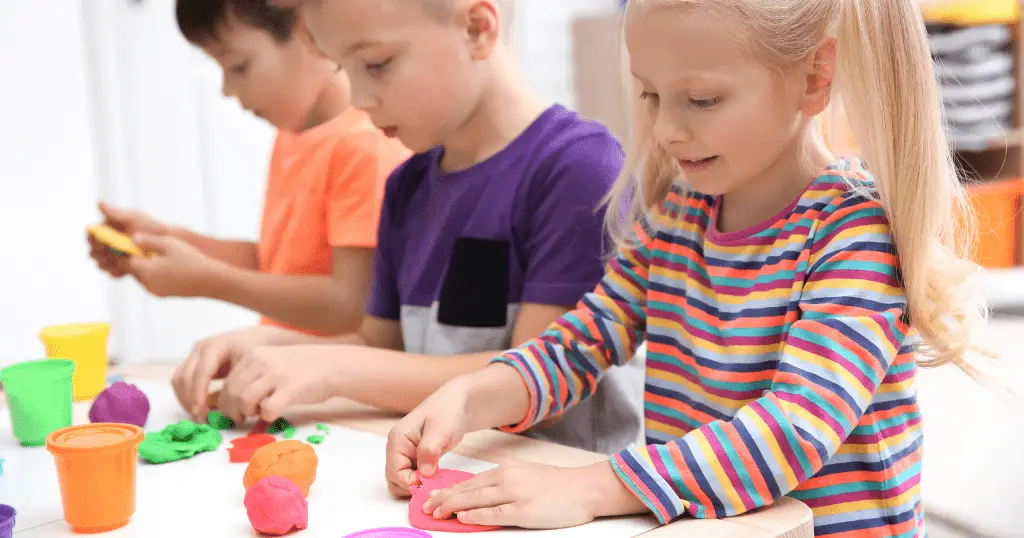
Socio-emotional Skills
One of the benefits of playdough in childcare is the development of socio-emotional skills. Socio-emotional skills include those that help children figure out who they are, how they are feeling, and what to expect when interacting with others.
Playdough provides opportunities for socio-emotional skill growth by promoting sharing of playdough and playdough toys, providing opportunities to create stories about what they are making, and collaborating with other children.
Self-Esteem and Confidence
Building confidence and self-esteem is a benefit of playdough in early childhood development. There are no wrong answers with playdough, if they want their tree to be purple and the sky to be green that’s okay, and that helps to build both self-esteem and confidence.
Self-esteem and confidence are also developed through shared playdough experiences. Playing, building, and creating stories together with playdough can help to build social skills, language development, self-esteem, and confidence as they work together with other children.

Creativity and Imagination
Playdough helps develop creativity and imagination in toddlers and preschoolers. They can pretend that what they are building is anything that their imagination can create like a castle or a fire-breathing dragon.
There are no limits to what their amazing minds can create. Sit down with your toddler and their playdough and be amazed at the stories that they tell you about all that they are building and creating.
Critical Thinking
Another benefit of playdough for children is how it teaches them to be critical thinkers and to use the tools around them to make their ideas into reality. Critical thinking skills are an important part of early childhood development.
Playdough teaches these skills in multiple ways. One example might be them wondering why their building keeps falling over. By thinking critically and widening the base of their building they discover that it will remain upright. Critical thinking skills are crucial to learning how to solve problems and learning these skills through hands on practice is ideal.

Benefits of making playdough with preschoolers
Making playdough with toddlers is a lot of fun and the process of making the playdough is a learning experience too. The benefits of making playdough with toddlers include learning how to measure, how to stir, and how to knead. Plus, isn’t it always more fun to play with something that you helped make from scratch?
Here is a simple no cook recipe for making playdough with kids.
Ingredients to Gather:
3 cups of All purpose flour
1 cup of salt
60 ml of oil
250 ml of warm (not hot) water
Food colouring (optional)
Method:
Mix the salt and flour together in a large bowl, and then add the oil.
Add the water and mix with a wooden spoon until the dough reaches your desired consistency.
Kneading will also improve the texture so break some dough out in large chunks and let your toddler knead the dough.
If you want to use food colouring you can simply mix it into the water before adding it to the dough.
If you would like to add additional sensory experiences to your playdough making you can place a drop or two of essential oil into the mixture.
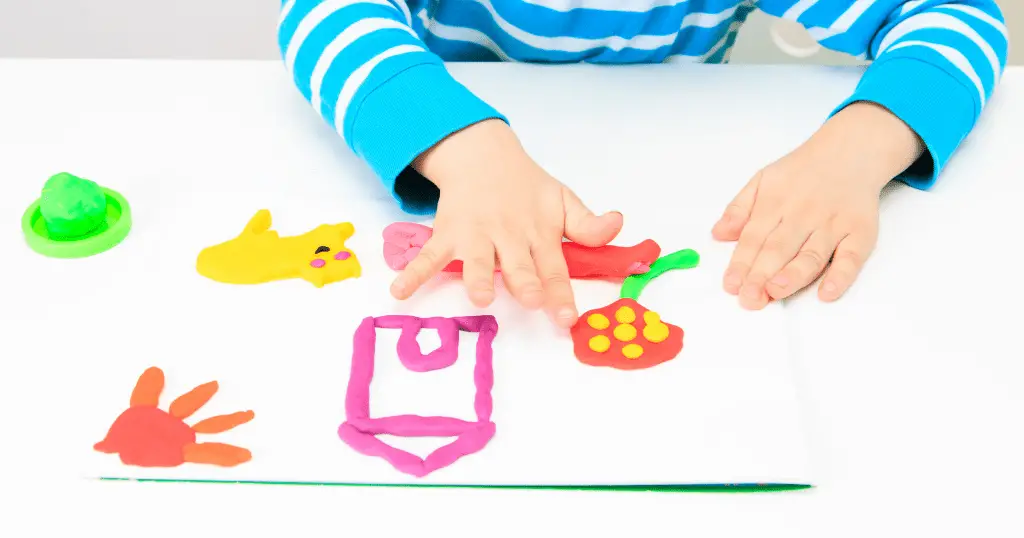
Ideas for Playdough Activities for Toddlers
- Playdough Stacking Towers
- Playdough Shape Mats
- Lego Playdough Activity
- Playdough Letter and Number Mats
- Playdough Straw Building
- Colouring Playdough
- Playdough Faces
Playdough Stacking Towers
Playdough stacking towers are an excellent playdough activity for toddlers. All you need are playdough, uncooked spaghetti noodles, and some Cheerios. Place the spaghetti noodles in the playdough and have your toddler slide the cereal rings down onto the sticks to make a tower. This is a perfect playdough activity for fine motor skills.
Playdough Shape Mats
This preschool playdough activity is great for teaching about shapes. Simply print out a variety of shapes like circles, squares, triangles, and octagons and let them mould the playdough to fit the shapes.
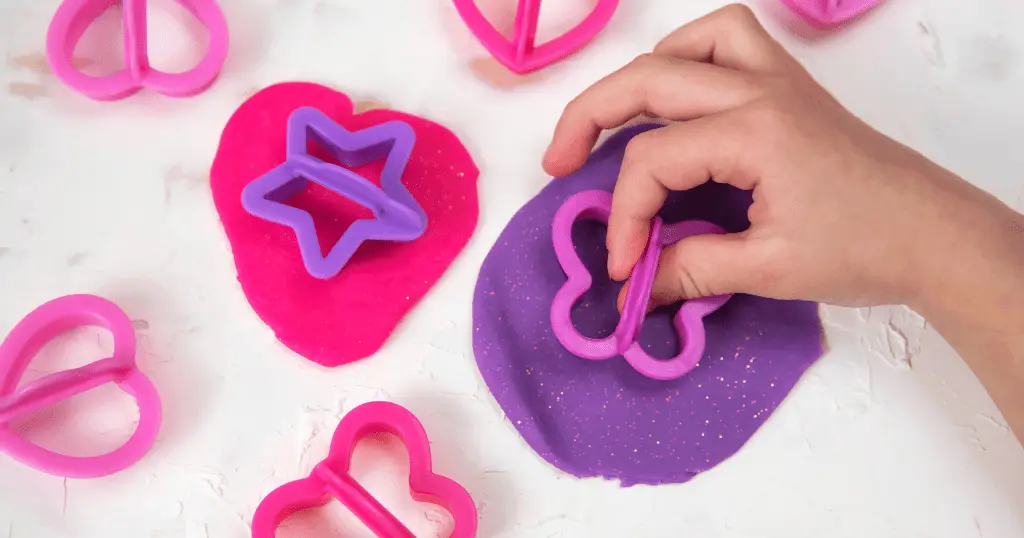
Lego Playdough Activity
This fun playdough activity just requires some playdough and some legos and if you have a toddler chances are you have both. Let the kids “stamp” the playdough with the legos to make different shapes, designs, and even letters. This activity is an excellent pre-writing practice activity and is also a playdough activity for fine motor skills.
Playdough Letter and Number Mats
If you are looking for a preschool playdough activity that helps to teach letter and number recognition then this might be the activity for you. Simply print letter and number worksheets and have your preschooler copy the letters and numbers by rolling and shaping playdough to match them.
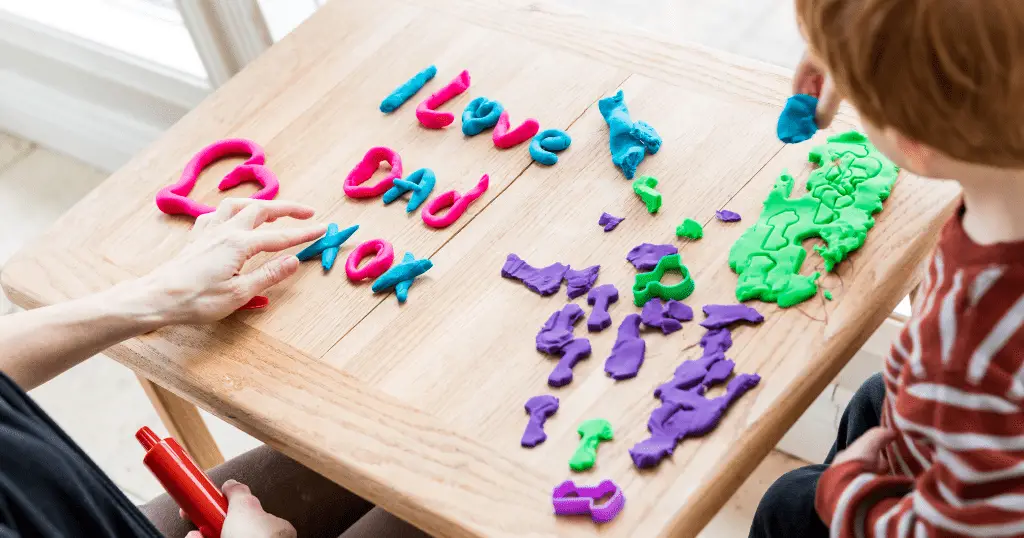
Playdough Straw Buildings
This fun playdough activity has your toddler learning how to build buildings with playdough and straws. Have them roll the playdough into balls and then use the straws to connect with each other and create their own buildings. Toddlers may make very basic buildings, but older preschoolers may even try for multi-storey ones.
Colouring Playdough
This playdough activity for kids is a lot of fun, and you will end up with some really beautiful playdough. You will need a batch of uncoloured playdough and some washable markers for this creative playdough activity. Give each child a ball of playdough to flatten out and allow them to write or draw on the playdough. When they start to play with the playdough the colour from the markers will spread throughout the playdough giving it a beautiful marbled appearance.
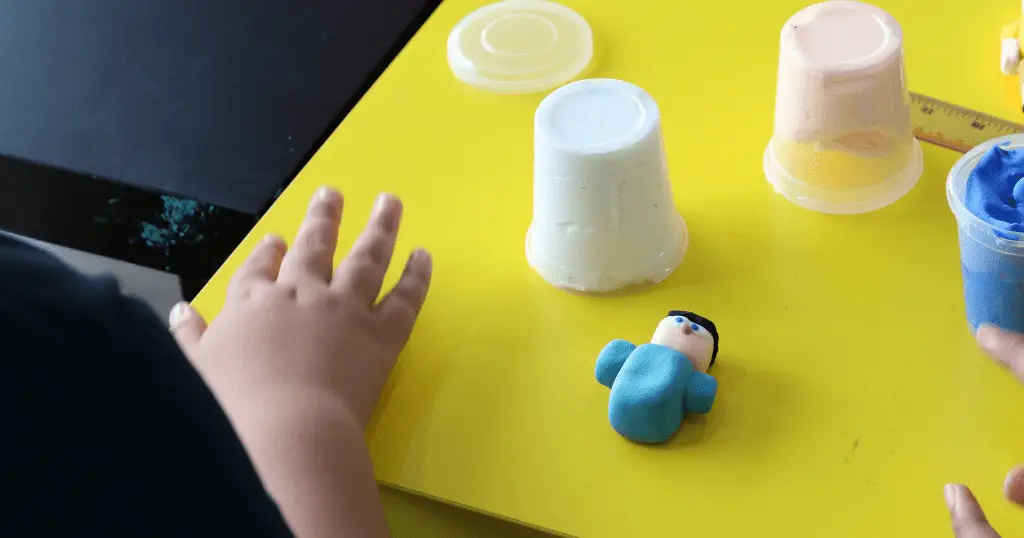
Playdough Faces
This playdough play idea allows you to discuss facial features, emotions, and more while allowing your toddler to be creative and practice their fine motor skills. Simply cut out some face shapes (or print out a template) and glue them to a piece of construction paper. Laminate the template or place it in a page protector (so you can use them over and over). Set out some playdough in a variety of colours and encourage your preschooler to create a face.
Best Way to Store Homemade playdough
Storing homemade playdough so that you can use it several times is easy. You can simply place it in an airtight container or a zip top bag and remove any excess air.
Alternatively, to keep the dough softer for longer, you can wrap it with cellophane before placing it in the airtight container or zip top bag. Some people recommend storing your homemade playdough in the refrigerator, but that is up to you. It will still keep for several play sessions if you don’t.
Best Playdough Sets, Australia
- Educational Craft Toy
- Skill development
- Great for play-dates, gifts, classrooms, and more
- Best for: Playdough enthusiasts
- Number of pieces: 20
- Ages: 24 months and up
Are you looking for the best playdough set for your toddler? Does your child want to explore playdough in ALL of the colours of the rainbow? Then this 20 piece set of playdough tubs each in a different colour is the choice for you.
With 20 different colours to choose from your child will never get bored, and they will have the ability to create amazingly colourful playdough creations. This set is perfect for a classroom since there are plenty of tubs of dough and colours to share, or for a home with a very detail oriented playdough artist.
- Sensory and educational craft toys
- Skills development
- Convenient and reusable
- Unlock kids creative side
- Best for: Those just introducing playdough and sensory play concepts.
- Number of pieces: 14
- Ages: 36 months and up
Are you looking for the best first playdough kit for your toddler? Then this might be the one for you. This set comes with four tubs of playdough in different colours, 4 shape stamps to cut the dough, scissors, a rolling pin, a cutting wheel, a playdough knife, and a case to hold them all!
Perfect for those just starting on their playdough journey or those that want to be able to take their dough on the go! This set has everything your toddler needs to have hours of creative fun with playdough.
- Grow hilariously long play doh hair
- Look fresh with a cut and a shave
- Included 8 tricolor play doh cans
- Kids can play pretend hair stylist and get crazy creative with the different tools
- Play Doh hairstyles of different shapes and thickn
- Best for: Children who love being creative and styling hair.
- Number of pieces: 16
- Ages: 36 months and up
This top playdough set is perfect for toddlers and children who love to use their imaginations and create crazy hairstyles, only to cut it and start all over again. They can grow the hair as long as they like and then roll it, style it, cut it, or shave it and start over.
This set comes with everything you need for hours of playdough entertainment including eight tri-colour tubs of dough to keep things colourful and creative. There are also barrettes, rollers, scissors, and a razor included for when it’s time to get a fresh new look.
Hasbro Play-Doh – Kitchen Creations Flip ‘N Pancakes Breakfast Playset
- Best for: Food themed creative play!
- Number of pieces: 22
- Ages: 36 months and up
Does your toddler love pretend cooking and pancakes? If so, these are the best playdough toys for them. There are four different shape stamps to make pancakes look unique, plates, forks, and a skillet to flip them in.
This set comes with 8 tubs of playdough so that your little chef can make colourful pancakes. There is also a syrup extruder that makes shapes so that they can decorate the pancakes that they will be serving up to everyone. A perfect gift for the child who loves playdough and cooking!
- Sensory and educational toy
- With 8 Play-Doh cans, more than 25 tools, and lots of molds
- Table features lots of built-in molds to help spark creativ
- Best for: Parents who want an all in one play and storage space for playdough.
- Number of pieces: 36
- Ages: 36 months and up
If you are looking for the best playdough tools and the best playdough kits then this is the kit for you. This set includes the best tools and playdough and a way to store them neatly after play is done.
This playdough kit comes with 8 tubs of playdough, stamps, scissors, plates, forks, and more. There is also a table that holds all of the playdough and tools so that when playtime is over you can simply pack it in the table and put it away.
Looking for more educational activities for toddlers?! Check out our post on the benefits of painting for toddlers and the benefits of dress up play next.





